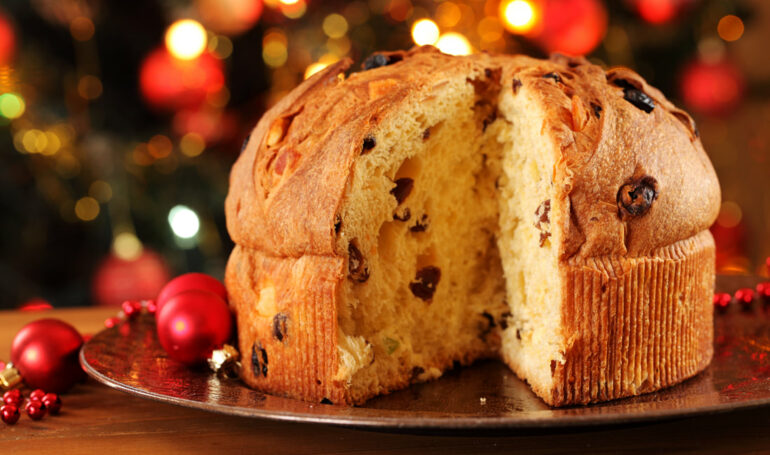
It’s Panettone Season!
Ideal for breakfast or as an after dinner treat, we’re officially heading towards panettone season. You’re unlikely to find any household in Italy during the month of December that doesn’t have a panettone in it. It’s seems to be the breakfast of choice during the month of December. Panettone is the sweet symbol of the Christmas period, and it was born “by chance” in Milan during the holiday season.
The cake, or sweet bread as some may wish to call it instead, is made from a mixture of flour, yeast, butter and sugar with the addition of salt, egg yolks, sultanas and candied fruit in pieces. A few are the theories of how this specialty bread was created, and as with many other dishes, the precise origins are uncertain, but here are two theories.
This is the most accredited legend about the origin of panettone. The protagonist is Ludovico il Moro, a lord in Milan, in the year 1495. It’s Christmas Eve, and folks are gathered around colossal tables, ready to celebrate with a lavish meal. In the kitchens, the cooks are all engaged in the preparation of dishes and delicacies that are very popular with diners.
They are so busy that the head cook asks a young man named Toni, a 12-year-old boy, to supervise the baking of the large donut-like sweets in the oven. What is slowly rising in the ovens in Palazzo Reale is the dessert to be served at the end of the meal, and must be perfect to conclude the Christmas Eve celebrations worthily.
But something goes wrong. Poor Toni, tired after days of intense work helping in the kitchen, falls asleep. A burning smell begins to emerge. The boy sleeps only a few minutes, but they are decisive for blowing up all the donuts, which all burn.
The boy then, frightened by the reaction of the head cook and the diners still eager for food, does not know how to justify himself. Until he remembers the dessert he had prepared for himself and his friends using the leftovers of the donut dough to which he had subsequently added eggs, butter, candied fruit and raisins.
So he decides to risk everything and offer it to the head chef as a dessert for the guests of the Duke, lord of Milan.
The head cook, at first doubtful, is literally entranced by the scent and surprised by the domed shape of the cake that he decides to serve it to the diners. The Duchess tastes it first. She opens her mouth, chews slowly and then declares: “Excellent!” And all the guests agree with her. The dessert is enjoyed by all accompanied by good wine.
The Duke at this point congratulates the head cook who, however, does not reveal that it was Toni, who prepared it.
But lies, as we know, have short legs, and soon the truth spreads in Milan. And on everyone’s lips, the dessert served to the Duke is called “el pan de Toni” in the Milanese dialect. Years pass and the recipe crosses the court walls, spreading throughout Italy, changing from “pan de toni” to panettone.
Another legend about the origin of panettone sees a nun as the protagonist: Sister Ughetta, was the head cook in a Milanese convent. She wanted to bake something special for Christmas, so she thought of making a cake for the other sisters using the few ingredients available in the monastery pantry.
She added eggs and sugar, candied fruit and raisins to the usual bread dough. To bless that Christmas bread she drew a cross on it with the knife. The nuns love it and once again, in Milan, word of mouth was incredibly fast. The Milanese began asking the nuns in the convent to bake this special bread for them to take home for the upcoming Christmas holiday.
Whichever theory you believe was the invention of panettone, be sure to pick one, or several, up for the upcoming holiday. They make wonderful hostess gifts and Italians find it practical to bring one when visiting friends or family. Some of my own preferred brands include Tre Marie and the classic Bauli.



What to Pack for Italy
Cosa Mettere in Valigia per l'Italia
Everyone is always asking me what they should pack for Italy,
so I’ve created a quick reference guide that you can use for your next trip.
Hint: You don’t need nearly as much as you think you do!

Leave a Reply